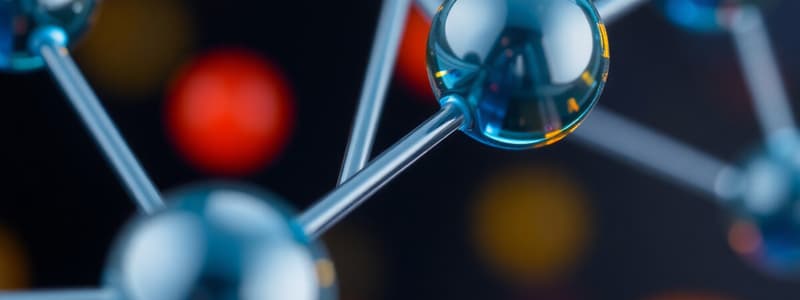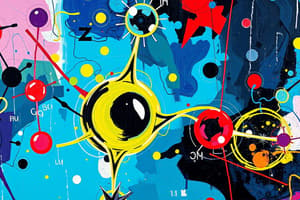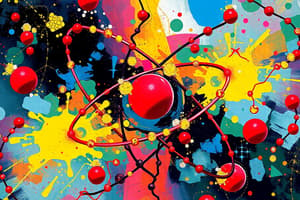Podcast
Questions and Answers
What is characteristic of the solid state of matter?
What is characteristic of the solid state of matter?
- Fixed shape and variable volume
- Variable shape and variable volume
- Fixed shape and fixed volume (correct)
- Fixed volume and variable shape
Which process describes the conversion of a liquid to a gas?
Which process describes the conversion of a liquid to a gas?
- Melting
- Vaporization (correct)
- Condensation
- Freezing
How is concentration defined in the context of solutions?
How is concentration defined in the context of solutions?
- The ratio of solvent to solute in a solution
- The amount of solute in a given amount of solvent or solution (correct)
- The mass of solute divided by its density
- The volume of the solvent in a mixture
What do strong acids and bases do when dissolved in water?
What do strong acids and bases do when dissolved in water?
Which law of thermodynamics states that energy cannot be created or destroyed?
Which law of thermodynamics states that energy cannot be created or destroyed?
What is the main focus of organic chemistry?
What is the main focus of organic chemistry?
What distinguishes isomers in chemistry?
What distinguishes isomers in chemistry?
What happens during nuclear fission?
What happens during nuclear fission?
What defines the atomic number of an element?
What defines the atomic number of an element?
Which type of bond involves the transfer of electrons?
Which type of bond involves the transfer of electrons?
What is the primary characteristic of valence electrons?
What is the primary characteristic of valence electrons?
In the periodic table, elements that are in the same group have what in common?
In the periodic table, elements that are in the same group have what in common?
What does balancing a chemical equation ensure?
What does balancing a chemical equation ensure?
What characterizes isotopes of an element?
What characterizes isotopes of an element?
Which trend is generally observed across the periodic table?
Which trend is generally observed across the periodic table?
Which type of reaction involves the formation of new substances by rearranging atoms?
Which type of reaction involves the formation of new substances by rearranging atoms?
Flashcards
Atom
Atom
The smallest unit of an element that retains the chemical properties of that element.
Nucleus
Nucleus
The central core of an atom containing protons and neutrons.
Proton
Proton
Positively charged particles found in the nucleus of an atom.
Neutron
Neutron
Signup and view all the flashcards
Electron
Electron
Signup and view all the flashcards
Atomic number
Atomic number
Signup and view all the flashcards
Chemical bond
Chemical bond
Signup and view all the flashcards
Covalent bond
Covalent bond
Signup and view all the flashcards
Solid
Solid
Signup and view all the flashcards
Liquid
Liquid
Signup and view all the flashcards
Gas
Gas
Signup and view all the flashcards
Solution
Solution
Signup and view all the flashcards
Solubility
Solubility
Signup and view all the flashcards
Base
Base
Signup and view all the flashcards
Neutralization reaction
Neutralization reaction
Signup and view all the flashcards
Study Notes
Atomic Structure
- Atoms are the fundamental building blocks of matter.
- Atoms consist of a nucleus containing protons and neutrons, with electrons orbiting the nucleus.
- Protons carry a positive charge, neutrons are neutral, and electrons carry a negative charge.
- The number of protons defines the atomic number and element.
- Atomic mass is the sum of protons and neutrons.
- Isotopes are atoms of the same element with different numbers of neutrons.
- Electron arrangement in shells or orbitals determines element's chemical properties.
- Valence electrons are the outermost shell electrons, involved in chemical bonding.
Bonding
- Chemical bonds hold atoms together to form molecules and compounds.
- Ionic bonds form between metals and nonmetals, through electron transfer.
- Covalent bonds form between nonmetals, through electron sharing.
- Metallic bonds form between metal atoms, with a "sea of electrons" holding positive metal ions together.
- Hydrogen bonds are a special dipole-dipole attraction where hydrogen bonds to a highly electronegative atom.
Periodic Table
- The periodic table organizes elements based on atomic number and recurring chemical properties.
- Elements are arranged in periods (rows) and groups (columns or families).
- Similar chemical properties are shared by elements in the same group.
- Elements are classified as metals, nonmetals, or metalloids.
- Metals generally lose electrons, nonmetals generally gain electrons, and metalloids have intermediate properties.
- Electronegativity, atomic radius, and ionization energy trends exist across the table.
- Alkali metals exhibit strong reactivity with water.
Chemical Reactions
- Chemical reactions involve rearranging atoms to form new substances.
- Reactants are initial substances, products are newly formed substances.
- Chemical equations represent reactions, showing formulas and coefficients for reactants and products.
- Balancing equations ensures mass conservation.
- Types of reactions include synthesis, decomposition, single displacement, double displacement, and combustion.
- Reaction rates depend on factors like temperature, concentration, and surface area.
States of Matter
- Matter exists as solids, liquids, and gases.
- Solids have fixed shape and volume, liquids have fixed volume and variable shape, and gases have neither.
- State changes involve melting, freezing, vaporization, condensation, and sublimation.
- The kinetic theory of matter describes particle behavior in different states, influenced by intermolecular forces.
Solutions
- Solutions are homogeneous mixtures of two or more substances.
- The solute is the dissolved substance, the solvent is the dissolving substance.
- Concentration expresses solute amount in a given solvent or solution.
- Concentration units include molarity, molality, and percentage.
- Solubility depends on factors like temperature and pressure.
Acids and Bases
- Acids release hydrogen ions (H+) when dissolved in water.
- Bases release hydroxide ions (OH-) when dissolved in water.
- The pH scale measures solution acidity or basicity.
- Strong acids/bases fully dissociate in water, weak ones do not.
- Neutralization reactions form salt and water from an acid and a base.
Thermodynamics
- Thermodynamics studies energy and heat relationships in chemical and physical systems.
- The first law of thermodynamics states energy conservation.
- The second law of thermodynamics states that entropy of an isolated system always increases.
- The third law of thermodynamics states that the entropy of a perfect crystal approaches zero at absolute zero.
Organic Chemistry
- Organic chemistry studies carbon-containing compounds.
- Carbon forms covalent bonds with other carbons and elements to form chains, branches, rings, and complex structures.
- Organic compound classes include alkanes, alkenes, alkynes, alcohols, and their derivatives.
- Isomers are molecules with the same formula but different structures.
- Functional groups are specific atom groups or bonds affecting compound properties.
Nuclear Chemistry
- Nuclear chemistry investigates radioactive isotopes, nuclear reactions, and processes in atomic nuclei.
- Radioactive decay transforms one element into another spontaneously.
- Nuclear fission and fusion are nuclear reactions splitting or combining nuclei to release energy.
- Radioisotopes have applications in medicine, industry, research, and dating organic remains.
Studying That Suits You
Use AI to generate personalized quizzes and flashcards to suit your learning preferences.




